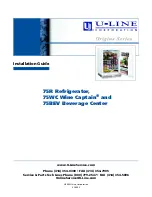
20
2
Salt
Salt is necessary to balance flavor in breads
and cakes; it also limits growth of yeast. Do not
increase or decrease amount of salt shown in
recipes.
Sugar
Sugar is important for color and flavor of
breads. It also serves as food for yeast since it
the supports fermentation process. Recipes in
this book that call for sugar require granulated
sugar.
Important: Do not substitute powdered sugar.
Artificial sweeteners cannot be used as
substitute, as yeast will not react properly with
them.
High-Altitude Baking
In high-altitude areas (over 3,000 feet) dough tends to rise faster, as there is less
air pressure. Therefore, less yeast is necessary. For more information on High
Altitude Baking guides contact:
Colorado Cooperative Extension Resource Center
Toll free: (877) 692-9358
E-mail: [email protected]
Website: www.ext.colostate/edu/depts/coopext
In dry climates, flour is drier and requires slightly more liquid.
In humid climates, flour is wetter and will absorb less liquid, so less liquid is
required.
ENGLISH
How to Use
This product is for household use only.
Important: Your bread maker has an intelligent fuse system designed to
protect the motor from overheating. It will automatically shut off the motor
if there is an overheat risk. If this occurs, unplug the appliance, wait a few
seconds for it to cool down, and plug in again following the instructions.
GETTING STARTED
• Remove packing materials and any stickers.
• Please go to www.prodprotect.com/applica to register your warranty.
• Place bread maker on dry, stable surface away from heat and areas where
cooking grease or water may splatter on unit. Do not place near edge of
countertop. If placing beneath cabinets, make sure there is enough room to
open the lid without interference.
Important: Your bread maker will bake up at 2-lb. loaf. Do not put larger
quantities of ingredients into bread pan. Bread will not mix and bake
correctly and bread maker may be damaged. (See MAxIMUM INGREDIENT
AMOUNTS.)
• Before first use, operate on Rapid White Course program without adding
ingredients to burn off manufacturing oils. (Follow instructions in USING
YOUR BREAD MAKER.)
Note: During first use, bread maker may smoke and/or emit an odor from
mineral oils used in manufacturing. This is normal.
MAxIMUM INGREDIENT AMOUNTS
• Bread courses: approximately 4 cups
• Quick breads and prepackaged cake mixes: 4 cups
• Dough courses: 4²/³ cups
• Jam: 3 cups of fruit
BREAD PAN TIPS
Inserting bread pan
Note: Remember to insert kneading paddle first, then add all ingredients
BEFORE inserting the bread pan into baking chamber in the order listed.
• When inserting bread pan into bread maker, make sure to set firmly in
place.
Removing bread pan
• To remove bread pan from baking chamber, hold handle with an oven mitt
and lift firmly.
Important: When you remove bread pan after baking, be sure to wear oven
mitts to prevent burning.
• After removing loaf (by turning bread pan upside down and shaking gently),
check to see that kneading paddle is removed from loaf. If it is stuck in
bread, use non-metal utensil to gently remove it, taking care not to scratch
the kneading paddle. Allow bread to cool before removing the kneading
paddle.












































